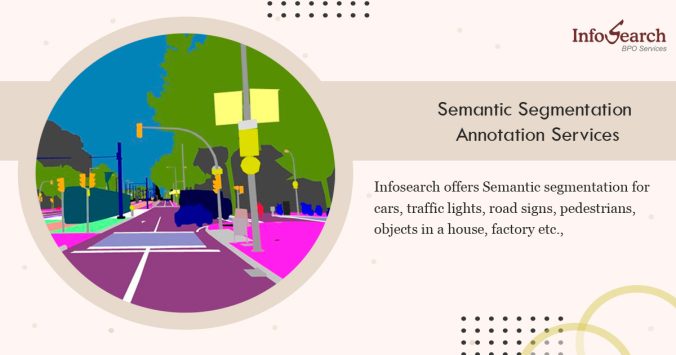Infosearch provides outstanding Semantic segmentation annotation services for machine learning. The process of adding attributes to each and every pixel of an image is known as semantic segmentation, which proves highly helpful in boosting the analysis of images. This method proves to be very useful in applications like medical image analysis, self-driving vehicles, and object detection in images and videos.
Here’s how semantic segmentation annotation enhances image analysis:
You can enjoy these benefits when you outsource semantic segmentation annotation.
1. Detailed Object Recognition: Unlike the traditional bounding box methods, semantic segmentation takes several labels that help to understand the pixels’ exact boundaries, making it easier to recognize each object in detail.
2. Improved Accuracy: It is indicated that fine-grained annotations make models more precise and effective for tasks such as classification and localization because more detailed information with regards to the objects represented in the image is provided.
3. Context Awareness: Semantic segmentation enables the models to trace the connection with other parts of the image and the objects to make a pass through them. This is especially important for assignments such as self-driving cars.
4. Enhanced Training Data: Another thing that makes annotated datasets include pixel level labels is that the method provides denser and more detailed training data.
5. Automation and Efficiency: Although manual annotation of images for semantic segmentation can consume a lot of time, it offers the opportunity to create automated tools to work with large amounts of data, which excludes the necessity for enormous amount of work in the future.
Applications of Semantic Segmentation
1. Medical Imaging: In medical imaging, semantic segmentation provides identification of lesions and labeling of different organs and tissues, with the help of which diagnosis and therapy planning are done.
2. Autonomous Driving: By help of semantic segmentation it is easier to identify the lanes, vehicles, pedestrians and other objects for the self-driving cars.
3. Agriculture: In terms of precision farming, semantic segmentation helps to observe the overall vegetation health, weeds, and other states of the fields.
4. Robotics: Semantic segmentation is used to let robots that have vision systems work more efficiently and effectively with their surroundings.
5. Augmented Reality (AR): Semantically, applications of AR employ segmentation to place digital information onto the real world in a correct manner, thus improving the experiences of the users.
Some of the methods used in the procedures for semantic segmentation annotation are discussed below:
Infosearch combines manual and automatic annotation, which is the best type of annotation.
1. Manual Annotation: It is a very time-consuming method, because human annotators label each pixel, but it is highly accurate.
2. Semi-Automatic Annotation: Blends the processes of using either human effort solely or automated procedures to provide the labels for tags or categories.
3. Fully Automatic Annotation: Employing machine learning for the process of annotating images is beneficial when dealing with big data.
Thus, through the implementation of semantic segmentation annotation, the capacity of image analysis can be greatly improved, greatly extending the usage of various applications in different fields. Contact Infosearch to outsource semantic segmentation annotation services.








Recent Comments